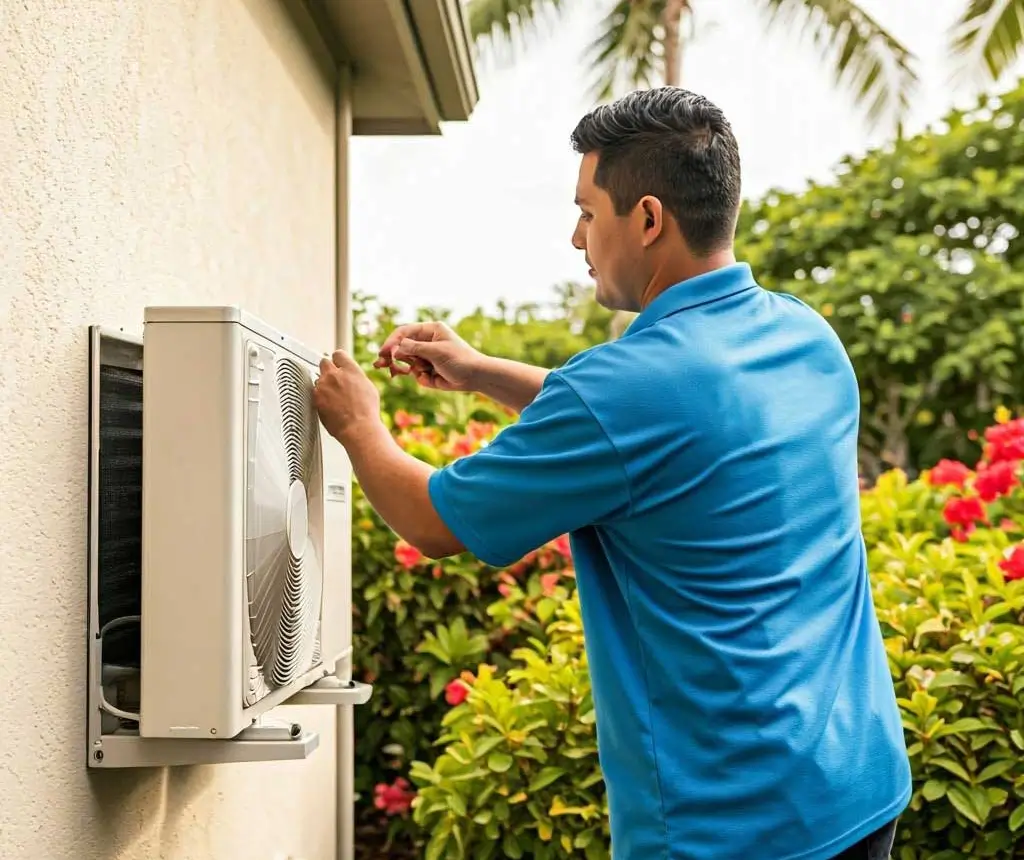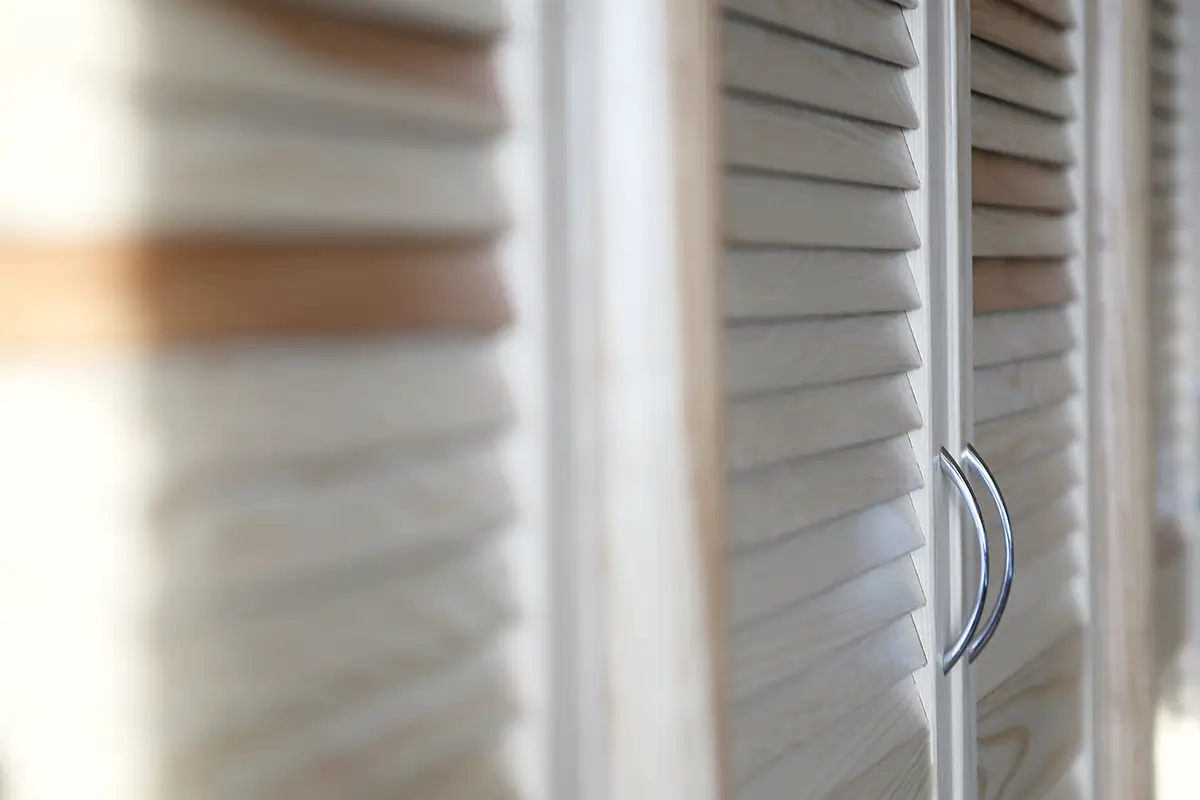Catching a glimpse of ice unexpectedly in Hawaii’s tropical climate always raises eyebrows. But when that frozen buildup appears on your home’s air conditioning unit, concern levels justifiably spike. Ice has no business forming on appliances engineered to regulate indoor temperatures and provide cooling comfort, right?
While this may seem like a cruel meteorological prank, the harsh reality is that iced-over AC units represent more than just a visual nuisance for island residents. That frosted condensation serves as a blaring indicator that potentially serious system issues demand immediate troubleshooting before permanent damage occurs.
From environmental factors stemming from Hawaii’s unique hot and humid atmosphere to internal mechanical failures, a variety of culprits frequently conspire to induce ice formation on air handlers and condensers. As counterintuitive as it seems, educating yourself on the common root causes provides your first line of defense against this vexing air conditioning conundrum plaguing many tropical dwellings.
Understanding How Air Conditioners Work
Grasping why ice weirdly forms on cooling appliances first requires understanding the basic mechanics behind how air conditioners function. While the concept seems straightforward, these climate-controlling units rely on a delicate atmospheric dance to repeatedly transfer thermal energy.
At the core, an AC is designed to extract heat from interior spaces and discharge it outside through a continuous cooling cycle. This is accomplished by circulating refrigerant lines between indoor evaporator coils and outdoor condenser coils.
Inside your home, warm air blows across the evaporator’s chilled coil surfaces, allowing the cold liquid refrigerant to absorb that thermal energy and transition into a hot gas vapor state. This heated vapor then travels outside to the condenser unit.
At the condenser, that gaseous refrigerant undergoes compression, condensing it back into a liquid form. As this condensation occurs, the collected heat naturally transfers outside via metal coils and a fan expelling the thermal load.
In theory, this continuous loop perpetually pulls warmth from your living spaces. But issues arise when anything disrupts the evaporator coil’s ability to maintain those frosty temperatures removing humidity from the air. Excess condensation then freezes directly onto the coil surfaces, rapidly obstructing airflow.
While straightforward in theory, these cooling principles rely on atmospheric conditions staying within strict parameters. Any lapses immediately create conditions ripe for ice accumulation – a frustrating issue all too common in Hawaii’s tropical climate.
Common Causes of Ice Formation
While frost buildup seems abnormal for cooling systems, a variety of environmental and mechanical factors frequently converge to create conditions ideal for ice accumulation on Hawaii’s air conditioning units. From airflow obstructions to low refrigerant levels, understanding these common catalysts provides your first defense against this vexing issue.
Restricted Airflow
Proper air circulation performs a vital role in AC operation by continually drawing humid warm air over the evaporator coil to be dehumidified and cooled. When airflow gets restricted due to clogged filters, blocked returns, or depleted fan speeds, that stagnant air saturates cold coil surfaces rapidly facilitating condensation freeze.
Low Refrigerant Levels
Refrigerant acts as the heat transfer medium for the entire cooling cycle. But when levels run low due to leaks or improper charging, the reduced refrigerant flow prevents evaporator coils from absorbing sufficient thermal energy. This causes coil temperatures to plummet below designed parameters, allowing any residual moisture to quickly freeze over.
Thermostat Issues
The thermostat’s sole purpose involves monitoring interior temperatures to regulate when ACs cycle on and off as needed. Faulty units continuously calling for cooling prevent systems from initiating defrost modes intermittently melting accumulated ice. Incorrect setting inputs can also force evaporator coils well below recommended temperatures.
Dirty Evaporator Coils
Even with proper airflow, the evaporator’s finned coil surfaces still gradually accumulate dust, dander, and grime buildup over time acting as insulation. This obstructs effective heat absorption from warm interior air. As the coil struggles to compensate, surface temperatures plummet allowing any moisture to freeze solid.
Mechanical Problems
Within the evaporator’s confined compartment, any number of mechanical failures from bad fan motors to stuck valves or frozen sensors can severely disrupt designed cooling cycles and temperatures. These glitches force continual refrigerant flows at improper rates swiftly facilitating ice crystals adhering to coil faces.
From obstructed airflow to mechanical malfunctions, this constellation of compounding factors form the perfect wintry recipe for ice to accumulate much to Hawaiian homeowners’ chagrin. Recognizing these common causes marks the first step toward implementing corrective actions thawing out comfort.
Identifying the Problem
While ice accumulation on air conditioning units always sets off alarm bells, actually pinpointing the precise culprit behind that frozen buildup proves trickier than it may seem initially. From obvious visual indicators to deeper mechanical symptoms, Hawaii homeowners need to keep a watchful eye out for these telltale signs signaling problems:
Visual Ice/Frost Buildup
This one seems like a no-brainer, but checking for any visible ice or heavy frosting clinging to your AC system’s interior evaporator coils or exterior condenser represents the most glaring red flag. If you can easily see icy buildup, that’s a strong indicator that your system ran too cold allowing condensation to freeze over surfaces.
Air Flow Obstruction
Before diving into potential system failures, first, inspect for any obvious airflow blockages like furniture obstructing supply vents or clogged air filters. Restricted circulation starves the evaporator of steady dehumidified airflow – the perfect catalyst for rapid ice accumulation on coil surfaces.
Warm Air Supply
Normally AC units blow crisp, cool air during operation. But if you’re only experiencing warm air from supply vents despite the system running, investigate potential issues like low refrigerant charges or mechanical component failures preventing sufficient heat transfer to the external condenser.
Excess Condensation
Even before complete ice formation takes hold, watch for signs of accelerated condensation or pooled moisture around your system’s interior components and drainage lines. This could signal inefficient dehumidification cycles priming coils for moisture freezeover if left unchecked.
Unusual System Cycling
Most modern HVAC units employ built-in timed defrosting modes forcing temporary shutdowns to melt away accumulated ice as needed. If you notice strange compressor cycling patterns no longer following this normal intermittent routine, it may indicate faulty defrost controls causing runaway buildup.
While visual confirmation provides the most obvious evidence, these secondary performance symptoms ultimately help pinpoint root causes behind any ice formation occurring. The key lies in catching deviations from normal cooling operation early before excessive buildup accelerates into far bigger repair headaches.
Steps to Take When You See Ice
Discovering icy buildup clinging to your air conditioning system justifiably sparks panic for any Hawaii homeowner counting on cool comfort. But before completely losing your chill, take a deep breath and initiate these crucial steps to quickly identify the root issue and restore normal cooling operation.
Shut Off The System
Once ice accumulation is visually confirmed, your first move involves completely shutting down the air conditioner by cutting its power supply. Allowing the system to continue running encased in ice accelerates component damage while preventing thawing. Consider it applying the emergency brake.
Clear Away Obstructions
With the AC unit powered off, take this opportunity to inspect all ventilation pathways for any obvious airflow obstructions like clogged filters or blocked returns. Remove any visible debris and replace filters as needed. Reestablishing smooth circulation helps alleviate conditions conducive to ice formation.
Monitor for Thawing
Now simply wait and monitor as residual warmth from the interior causes that built-up ice to gradually thaw and melt away over several hours. Avoid any attempts to forcibly pick away or dislodge ice, as this risks damaging delicate coil fins and components.
Locate Leak Sources
As thawing progresses, keep a close eye out for any active refrigerant leaks that deplete system charge levels setting the stage for ice issues. Telltale signs include pumped oil residue, whistling noises, and odors. Identifying leak locations necessitates professional AC diagnosis and repairs.
Reset Drain Lines
With the unit drained and thawed, ensure all condensate drain lines are properly clearing away excess interior moisture. Clogged drainage backs up into equipment generating more condensation susceptible to refreezing into ice.
Run System To Verify
Once all preliminary issues like obstructions and drainage get resolved, carefully restore power and restart your AC to verify if the ice accumulation problem has cleared and normal system cooling cycles resume. Continue monitoring operation over the coming days for any reoccurring symptoms.
By taking methodical steps to thaw out existing ice buildup while resolving underlying airflow and drainage factors, many Hawaii homeowners can resolve mild accumulation issues themselves. But any indications of refrigerant leaks, mechanical failures, or problematic refreezing warrant enlisting professional HVAC service.
Preventative Measures
While implementing reactive measures to clear away ice buildup provides a temporary fix, savvy Hawaiian homeowners understand the importance of taking preventative steps to avoid this cooling calamity from reoccurring. A proactive approach focused on routine maintenance and environmental consideration proves the best defense against AC iceover.
Ensure Proper Installation
From system size and ductwork configuration to calculating appropriate refrigerant charges, ensuring your air conditioning setup meets engineering specifications from the start prevents running inefficiencies conducive to ice issues. Always enlist trained professional installers to get things right initially.
Change Air Filters Regularly
Those clogged air filters restrict vital airflow across evaporator coils enabling excess moisture accumulation to freeze over. Commit to routinely replacing them every 1-3 months based on usage and environmental factors like dusty conditions.
Clear Debris Regularly
In addition to filters, make efforts to carefully clear away any visible buildup of dust, dander, pollen, or yard debris collecting around outdoor condenser units and indoor vents/returns at least seasonally. This preserves optimal airflow pathways.
Insulate Properly
For Hawaiian homes, ensuring attics and wall cavities are properly insulated against radiant heat gain minimizes cooling load demands placed on AC systems. Less strain equates to reduced runtime hours for ice formation windows to open up.
Utilize Dehumidifiers
Since Hawaii’s balmy climate loads interior air with excessive moisture content, supplementing strained AC systems with dedicated dehumidifiers reduces that atmospheric humidity burden allowing systems to operate more efficiently.
Maintain Regularly
Beyond basic DIY efforts, invest in annual professional HVAC maintenance involving comprehensive cleaning, system charging, airflow evaluation, and component diagnostics. Catching small issues prevents them from escalating into major cooling breakdowns and ice buildup situations.
From ensuring flawless installation to combining dehumidification with insulation strategies, attacking this ice accumulation issue requires a multipronged approach for Hawaiian residents. With proper preventative protocols in place, your air conditioner can keep its cool while providing your home reliable comfort year-round.
The Impact of Hawaii’s Climate
While air conditioning ice buildup proves a perplexing problem capable of disrupting cooling systems anywhere, Hawaii’s unique tropical environment creates atmospheric conditions particularly conducive to this frustrating phenomenon. Understanding how the islands’ climate exacerbates factors enabling ice formation provides an important context.
High Humidity Levels
Thanks to warm ocean temperatures and abundant precipitation, Hawaii’s air carries extremely high moisture content year-round. This excessive atmospheric humidity infiltrating AC systems overloads evaporator coils tasked with dehumidification duties before cooling can occur efficiently. Excess condensation inevitably freezes.
Minimal Temperature Variance
Most mainland regions experience drastic seasonal temperature swings allowing air conditioners periodic respites to shed any accumulated ice buildup naturally through thaw cycles. Hawaii’s relatively constant year-round warmth means systems run continuously without these frozen coil-clearing reprieves.
Sea Air Exposure
Those salty ocean breezes may make for idyllic island living, but that chloride-rich air steadily degrades exposed AC components like condenser coils over time. Corrosion impacts everything from proper airflow levels to refrigerant charge retention – both catalysts for disruptive ice accumulation.
Inconsistent Rainfall
While overall rainfall volume remains high, Hawaii’s tropical patterns frequently feature heavy downpours punctuated by extended dry spells. This fluctuation stresses air conditioning systems working overtime to extract humidity during muggy stretches before suddenly downsizing demands during drier periods. These operational fluctuations open windows for ice problems.
Environmental Contamination
Unfortunately, Hawaii’s paradisiacal atmosphere also carries increased risks from organic particulate and chemical contaminants getting circulated through AC systems. Heightened dust, pollen, and volcanic haze compound interior coil buildup accelerating condensation freezeover when left unaddressed.
While perfectly equipped to handle demanding cooling duties, air conditioning equipment still struggles against Hawaii’s unique environmental variables continuously enabling conditions ideal for ice formation issues. Recognizing these inherent challenges marks the first step toward implementing comprehensive preventative protocols.
When to Call a Professional
Even for seasoned DIY-ers adept at basic air conditioning maintenance, some situations involving ice buildup demand the expert attention only trained HVAC professionals can provide. Knowing when to wave the white flag and engage qualified technicians proves crucial for Hawaiian homeowners looking to resolve root causes effectively.
Recurring Ice Accumulation
If ice continually reforms on your AC system soon after manually clearing it away yourself, that persistent reoccurrence likely signals an underlying mechanical issue beyond basic airflow restrictions or drainage problems. Certified techs possess diagnostic equipment to uncover component failures like stuck valves or refrigerant leaks enabling freeze-ups.
Refrigerant Leaks
Speaking of refrigerant, any suspected leaks depleting system charge levels undoubtedly warrant professional investigation and repair. Handling this volatile cooling medium requires proper EPA certification to safely seal leaks and recharge lines to factory specifications. Attempting DIY refrigerant work invites safety hazards.
Electrical Issues
While homeowners can check for obvious airflow blockages, any electrical control malfunctions like faulty thermostats or board failures necessitate HVAC technician expertise. These specialists utilize amp testers and diagnostic software checking for overloaded circuits, loose wiring connections, or components drawing excessive power creating conditions ripe for icing.
Mechanical Breakdowns
From snapped fan belts and seized motor bearings to failed compressors and stripped gears, a host of potential mechanical breakdowns within AC system guts can initiate the sorts of performance issues enabling ice formation. Technicians inspect, disassemble, and repair/replace these complex components as needed.
Warranty Concerns
Whether dealing with a brand new air conditioning installation or an aging unit still under warranty protection, any issues potentially covered require professional HVAC service to comply with manufacturing guidelines. Taking amateur repair measures often voids warranty protections costing you more ultimately.
While sufficient HVAC knowledge empowers homeowners to resolve basic ice accumulation triggers themselves, any signs of major systemic failures indicate it’s time to call in the cavalry. Certified technicians provide specialized diagnostic equipment, technical training, and safety certifications to definitively uncover root causes behind ice buildup while resolving them properly.
Don’t Let Ice Ruin Your Cool Vibes – Trust AC Ice Experts at Steve’s Plumbing!
For Hawaiian residents, discovering ice accumulating on air conditioning systems feels like a cruel climatic prank. But that frozen buildup indicates far more disconcerting issues lurking behind the scenes disrupting your home’s cooling capabilities and efficiency. From airflow obstructions and mechanical failures to refrigerant leaks, multiple compounding factors enable condensation freezeover.
When DIY efforts like clearing debris or thawing units fail to resolve recurring icing episodes, it’s time to call in the AC professionals at Steve’s Plumbing & AC Service. Our certified HVAC technicians deploy specialized diagnostic tools identifying root causes – everything from electrical gremlins to systemic refrigerant leaks. We then resolve those component issues through repairs or full system overhauls as needed.
As a local Hawaii company, our team intimately understands the unique environmental challenges our tropical climate creates for air conditioning systems. Let us implement comprehensive preventative maintenance protocols keeping your equipment operating at peak performance year-round. Don’t surrender to disruptive cooling system ice accumulation any longer. Call Steve’s at (808) 563-4054!










